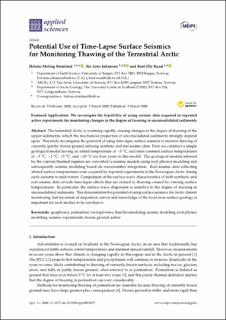| dc.contributor.author | Stemland, Helene Meling | |
| dc.contributor.author | Johansen, Tor Arne | |
| dc.contributor.author | Ruud, Bent Ole | |
| dc.date.accessioned | 2021-02-22T09:12:43Z | |
| dc.date.available | 2021-02-22T09:12:43Z | |
| dc.date.created | 2020-05-28T13:23:22Z | |
| dc.date.issued | 2020 | |
| dc.Published | Applied Sciences. 2020, 10:1875 (5), 1-17. | |
| dc.identifier.issn | 2076-3417 | |
| dc.identifier.uri | https://hdl.handle.net/11250/2729393 | |
| dc.description.abstract | The terrestrial Arctic is warming rapidly, causing changes in the degree of freezing of the upper sediments, which the mechanical properties of unconsolidated sediments strongly depend upon. This study investigates the potential of using time-lapse surface seismics to monitor thawing of currently (partly) frozen ground utilizing synthetic and real seismic data. First, we construct a simple geological model having an initial temperature of −5 °C, and infer constant surface temperatures of −5 °C, +1 °C, +5 °C, and +10 °C for four years to this model. The geological models inferred by the various thermal regimes are converted to seismic models using rock physics modeling and subsequently seismic modeling based on wavenumber integration. Real seismic data reflecting altered surface temperatures were acquired by repeated experiments in the Norwegian Arctic during early autumn to mid-winter. Comparison of the surface wave characteristics of both synthetic and real seismic data reveals time-lapse effects that are related to thawing caused by varying surface temperatures. In particular, the surface wave dispersion is sensitive to the degree of freezing in unconsolidated sediments. This demonstrates the potential of using surface seismics for Arctic climate monitoring, but inversion of dispersion curves and knowledge of the local near-surface geology is important for such studies to be conclusive. | en_US |
| dc.language.iso | eng | en_US |
| dc.publisher | MDPI | en_US |
| dc.rights | Navngivelse 4.0 Internasjonal | * |
| dc.rights.uri | http://creativecommons.org/licenses/by/4.0/deed.no | * |
| dc.title | Potential Use of Time-Lapse Surface Seismics for Monitoring Thawing of the Terrestrial Arctic | en_US |
| dc.type | Journal article | en_US |
| dc.type | Peer reviewed | en_US |
| dc.description.version | publishedVersion | en_US |
| dc.rights.holder | Copyright 2020 by the authors. | en_US |
| dc.source.articlenumber | 1875 | en_US |
| cristin.ispublished | true | |
| cristin.fulltext | original | |
| cristin.qualitycode | 1 | |
| dc.identifier.doi | 10.3390/app10051875 | |
| dc.identifier.cristin | 1813048 | |
| dc.source.journal | Applied Sciences | en_US |
| dc.source.40 | 10:1875 | |
| dc.source.14 | 5 | |
| dc.identifier.citation | Applied Sciences. 2020, 10 (5), 1875. | en_US |
| dc.source.volume | 10 | en_US |
| dc.source.issue | 5 | en_US |

